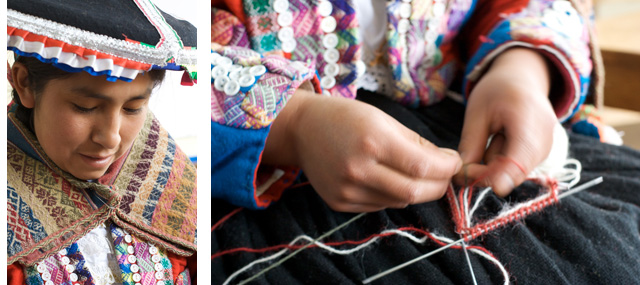
My favorite tools are the metal needles I got from my teacher Phetra, a 16 year old from Pitumarca Peru. They are equivalent to a US0 or a 2.0mm, and are made from sharpened wires.
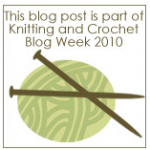
I chose the Wildcard topic for “KnitCroBlo6” google for more!
Hand Knitting Blog & Knitting Patterns
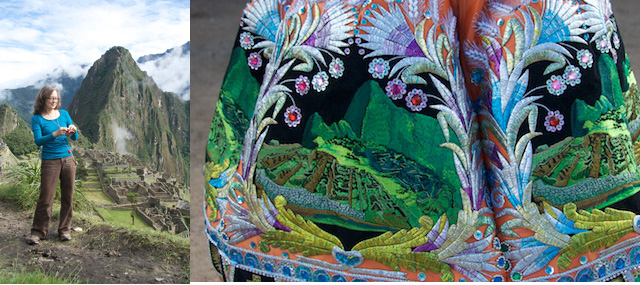
Where do I like to knit? At the top of the world.
The embroidery is Miss Machu Picchu’s skirt.

google “knitcroblo5” for more!

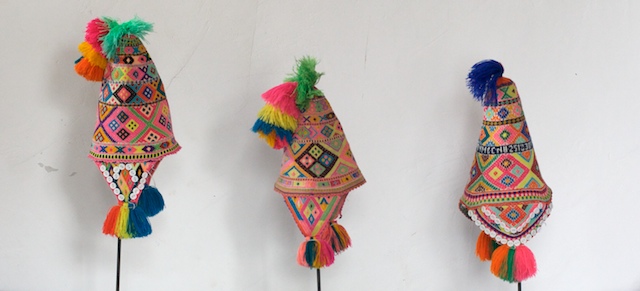
I found these scattered across Peru, the one on the far left in Lima, the middle one in Cusco, and the one on the right in Aguas Calientes, by Machu Picchu; they are all typical men’s hats of the Cusco region. There are subtle clues which might let us know where they are from. The two on the left are very similar, notice the earflaps have similar patterning and are constructed the same way, only the one on the far left has been fancied up with buttons. The color arrangement of their top pompoms are identical.
The chullu on the right has a different earflap construction, the center is knit downwards like the other two, but with a sewn on edging which matches the motifs in the diamonds above. It is perhaps my favorite hat, personalized with the name of the makers village, his own name and even his phone number – a sure way to get the girls!
Notice how many different colors are found in every row, each of them requiring a separate bobbin. I counted 34 colors in one row! The stitch gauge makes traditional fair isle knitting seem positively bulky! The center chullu has teensy tiny stitches-20 to the inch. The other two are 15 and 14 to the inch.
The technique for all three is what Cynthia Le Court Samaké named a “Corded Join”, inevitably there are several ways of doing it. The man I watched, didn’t knit at all, strictly purled…up to the cord, wrap and back around the other way, purling in reverse, never turning the work. The “Knitted Float Intarsia” I mentioned before, achieves the same result in a different manner, without the cord.
I’m practicing and trying to learn, but I feel all thumbs, which is helpful really, you use your thumbs a lot, makes it easier. Some of the people I saw in Peru were not especially fast knitters, but the ones who were – were blindingly fast – little bobbins bobbing along.


Read other accounts of “A New Skill”: google knitcroblo4
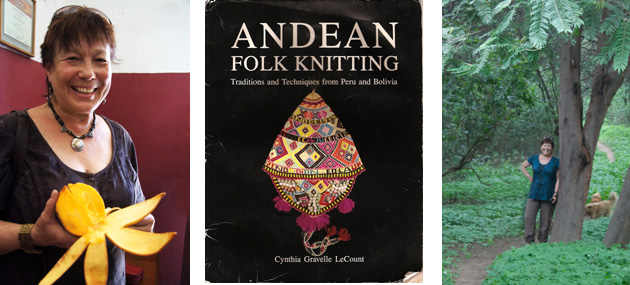

As a rule I jump on bandwagons at the last moment…when I learned of today’s topic for Knit and Crochet Blog Week: “One Great Knitter” I knew it was about time I introduced you to Cynthia. You may know her as the author of what is indisputably the greatest book on Andean knitting: Andean Folk Knitting Traditions and Techniques from Peru and Bolivia. The book is so wonderful it boggles the mind, scholarly yet entertaining, it includes history, travelogue, techniques explained in detail, charted motifs, charming patterns – everything I love in a knitting book double-plus! I think its my favorite knitting book of all time, and it was the ONLY book to survive our house fire, crazy, lying atop the coals. Sadly the book is out of print, and perfectionist that she is, Cynthia would like to update it before releasing it again.
My recent trip to Peru was hosted by Cynthia, who’s organization Behind the Scenes Adventures takes small groups of fiber enthusiasts on journeys all over the world – Mali, Mexico, Turkey, Laos, India. The theme of my trip was Textiles and Archeology, an apt combination as Peru has one of the most ancient textile traditions in the world, and a perfect combination for my mom and I, since shes an archeology buff and well…you know about me. It really took touring the archeological sites to grasp the full impact that textiles have on the region, and I thank Cynthia for bringing that understanding into full focus.
Cynthia herself is a delight to be with, eminently knowledgeable, effervescently cheerful with a natural curiosity that knows no bounds. She tirelessly herded us from one fantastic location to another. She’s been to Peru a zillion times, knows everyone everywhere, knows what’s good to eat, where to shop and for what, and is never to busy to pause and describe a complex technique. Oh Lordy, I could write all night and into tomorrow and still not capture how truly inspiring Cynthia is and why I admire her so much. She is beyond a doubt One Great Knitter.
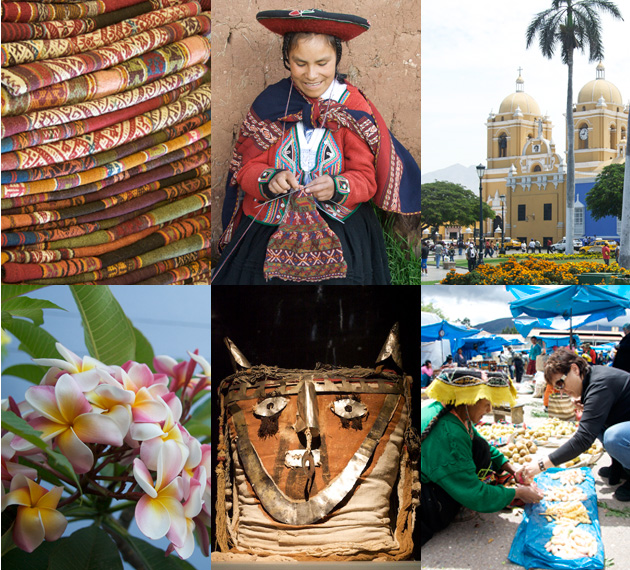

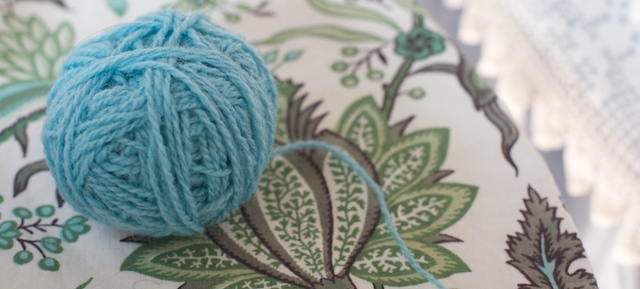
endless…
….. this is the beginning of UK Knit Camp Special Special Socks designed especially for my Fair Isle Sock Class
Friday August 13th 9:30-12:30, Sterling Scotland.
I hope it will be a pattern that inspires you to delve into making up your own!
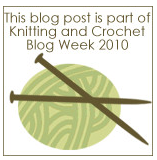
Find more here!

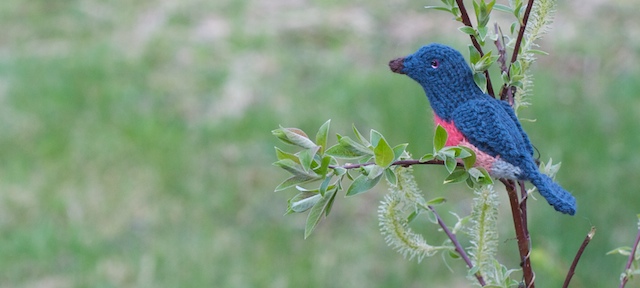
Spring is so early, daffodils, violets and the sky already filled with birdsong. I look and look through my binoculars, trying to locate the musicans, theirs feathered chests swelling with song. I only seem to spy the tiny silent ones, flitting near the ground, intent on their bug bussiness. The warm weather had me itching to be delinquent. I abandoned my current project and set to making birds, capturing with my needles, the elusive songsters.
It wasn’t entirely frivolous, I was testing an Andean technique I had observed, but not yet tried, a type of intarsia, which I think I shall call Knitted Float Intarsia….or something like that. Because that is exactly what they do when the yarn is on the wrong side of the motif in circular knitting. Only they usually purl, and they purl “backwards” to boot!
My bluebird is my first go at Knitted Float Intarsia, I was trying to adapt the technique to my style of continental knitting, which worked. A bit fussy, which it just plain is – however, I have almost concluded may be easier to do the Andean way, purling, from the inside. You’ve got more control of your floats that way. Plus, when you loop the yarn around the back of your neck, like they often do, you can really make the stitches pop into place, keeping the tension tight.
I feel like I’m learning to knit all over again. I was taught to knit when I was four, by a teenaged neighbor who promptly ripped out all my knitting when was time to take it off the needle. Much later, in college, I “learned again” although I found I already knew how. I “learned again” when I decided it would be much cooler to knit continental style. Now I’m learning the basics again a totally different way!
 Google knitcroblo1 to find out more!
Google knitcroblo1 to find out more!